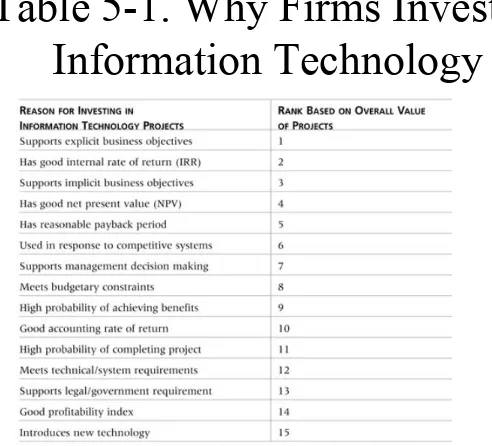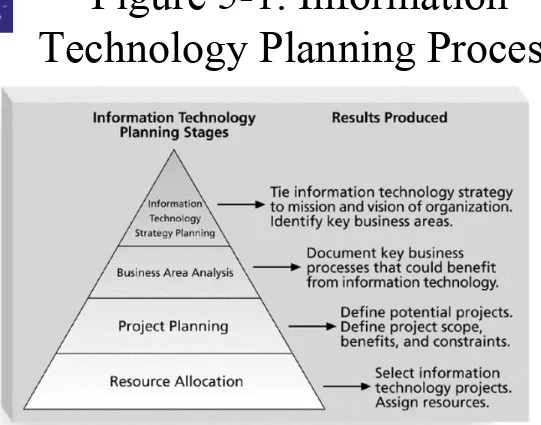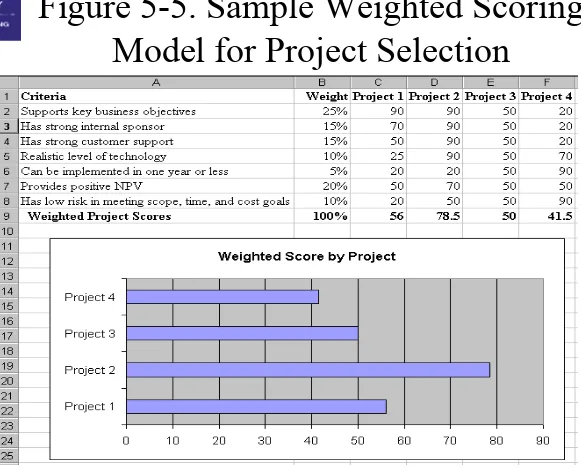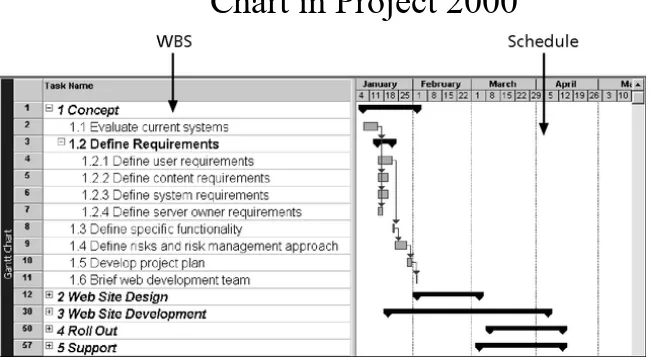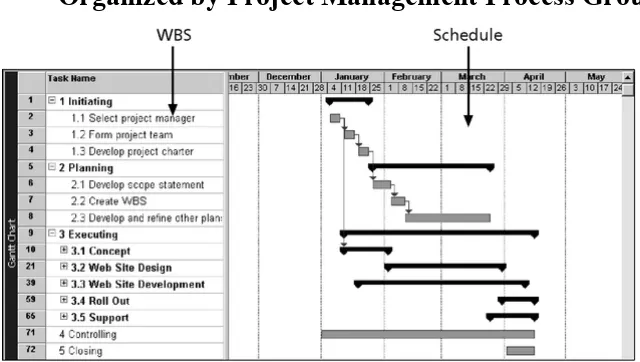Chapter 5:
Learning Objectives
• Understand the elements that make good project scope management important
• Describe the strategic planning process, apply
different project selection methods, such as a net present value analysis, a weighted scoring model, and a balanced scorecard, and understand the
importance of creating a project charter
Learning Objectives
• Discuss the scope definition process and
construct a work breakdown structure using the analogy, top-down, bottom-up, and mind
mapping approaches
• Understand the importance of scope verification and scope change control to avoid scope creep on information technology projects
What is Project Scope Management?
• Scope refers to all the work involved in creating the products of the project and the processes
used to create them. It defines what is or is not to be done
• Deliverables are products produced as part of a project, such as hardware or software, planning documents, or meeting minutes
Project Scope Management Processes
• Initiation: beginning a project or continuing to the next phase
• Scope planning: developing documents to provide the basis for future project decisions
• Scope definition: subdividing the major project deliverables into smaller, more manageable
components
• Scope verification: formalizing acceptance of the project scope
Project Initiation: Strategic Planning
and Project Selection
• The first step in initiating projects is to look at the big picture or strategic plan of an
organization
• Strategic planning involves determining long-term business objectives
Identifying Potential Projects
• Many organizations follow a planning process for selecting IT projects
• First develop an IT strategic plan based on the organization’s overall strategic plan
• Then perform a business area analysis • Then define potential projects
Figure 5-1. Information
Methods for Selecting Projects
• There are usually more projects than available time and resources to implement them
• It is important to follow a logical process for selecting IT projects to work on
• Methods include:
– focusing on broad needs – categorizing projects
– performing financial analyses – using a weighted scoring model
Focusing on Broad
Organizational Needs
• It is often difficult to provide strong justification for many IT projects, but everyone agrees they have a high value
• “It is better to measure gold roughly than to count pennies precisely”
• Three important criteria for projects: – There is a need for the project
– There are funds available
Categorizing IT Projects
• One categorization is whether the project addresses
– a problem
– an opportunity – a directive
• Another categorization is how long it will take to do and when it is needed
Financial Analysis of Projects
• Financial considerations are often an important consideration in selecting projects
• Three primary methods for determining the projected financial value of projects:
– Net present value (NPV) analysis – Return on investment (ROI)
Net Present Value Analysis
• Net present value (NPV) analysis is a method of calculating the expected net monetary gain or
loss from a project by discounting all expected future cash inflows and outflows to the present point in time
• Projects with a positive NPV should be
NPV Calculations
• Determine estimated costs and benefits for the life of the project and the products it produces • Determine the discount rate (check with your
organization on what to use)
• Calculate the NPV (see text for details) • Notes: Some organizations consider the
investment year as year 0, while others start in year 1. Some people enter costs as negative
Return on Investment
• Return on investment (ROI) is calculated by
subtracting the project costs from the benefits and then dividing by the costs
ROI = (total discounted benefits - total discounted costs) / discounted costs
• The higher the ROI, the better
• Many organizations have a required rate of return or minimum acceptable rate of return on an investment • Internal rate of return (IRR) can by calculated by
Payback Analysis
• Another important financial consideration is payback analysis
• The payback period is the amount of time it will take to recoup, in the form of net cash inflows, the net dollars invested in a project
• Payback occurs when the cumulative discounted benefits and costs are greater than zero
Weighted Scoring Model
• A weighted scoring model is a tool that provides a systematic process for selecting projects based on many criteria
– First identify criteria important to the project selection process
– Then assign weights (percentages) to each criterion so they add up to 100%
– Then assign scores to each criterion for each project
– Multiply the scores by the weights and get the total weighted scores
• The higher the weighted score, the better
• See “What Went Right?” for a description of how a
Implementing a Balanced
Scorecard
• Drs. Robert Kaplan and David Norton developed this approach to help select and manage projects that align with business strategy
• A balanced scorecard converts an organization’s value drivers, such as customer service,
innovation, operational efficiency, and financial performance to a series of defined metrics
Project Charters
• After deciding what project to work on, it is important to formalize projects
• A project charter is a document that formally recognizes the existence of a project and
provides direction on the project’s objectives and management
Scope Planning and the
Scope Statement
• A scope statement is a document used to
develop and confirm a common understanding of the project scope. It should include
– a project justification
– a brief description of the project’s products – a summary of all project deliverables
– a statement of what determines project success
Scope Planning and the Work
Breakdown Structure
• After completing scope planning, the next step is to further define the work by breaking it into manageable pieces
• Good scope definition
– helps improve the accuracy of time, cost, and resource estimates
– defines a baseline for performance measurement and project control
The Work Breakdown
Structure
• A work breakdown structure (WBS) is a deliverable-oriented grouping of the work
involved in a project that defines the total scope of the project
• It is a foundation document in project
management because it provides the basis for
Table 5-3. Intranet WBS in Tabular Form
1.0 Concept
1.1 Evaluate current systems 1.2 Define Requirements
1.2.1 Define user requirements 1.2.2 Define content requirements 1.2.3 Define system requirements
1.2.4 Define server owner requirements 1.3 Define specific functionality
1.4 Define risks and risk management approach
1.5 Develop project plan
1.6 Brief Web development team 2.0 Web Site Design
Figure 5-9. Intranet WBS and Gantt Chart
Approaches to Developing WBSs
• Using guidelines: Some organizations, like the DoD,provide guidelines for preparing WBSs
• The analogy approach: Review WBSs of similar projects and tailor to your project
• The top-down approach: Start with the largest items of the project and break them down
• The bottom-up approach: Start with the detailed tasks and roll them up
Basic Principles for Creating WBSs*
1. A unit of work should appear at only one place in the WBS.
2. The work content of a WBS item is the sum of the WBS items below it.
3. A WBS item is the responsibility of only one individual, even though many people may be working on it.
4. The WBS must be consistent with the way in which work is actually going to be performed; it should serve the project team first and other purposes only if
practical.
5. Project team members should be involved in developing the WBS to ensure consistency and buy-in.
6. Each WBS item must be documented to ensure accurate understanding of the scope of work included and not included in that item.
7. The WBS must be a flexible tool to accommodate inevitable changes while
properly maintaining control of the work content in the project according to the scope statement.
Scope Verification and Scope
Change Control
• It is very difficult to create a good scope statement and WBS for a project
• It is even more difficult to verify project scope and minimize scope changes
• Many IT projects suffer from scope creep and poor scope verification
– FoxMeyer Drug filed for bankruptcy after scope creep on a robotic warehouse
– Engineers at Grumman called a system “Naziware” and refused to use it
Suggestions for Improving User
Input
• Develop a good project selection process and insist that sponsors are from the user
organization
• Have users on the project team in important roles
• Have regular meetings
• Deliver something to users and sponsors on a regular basis
Suggestions for Reducing Incomplete
and Changing Requirements
• Develop and follow a requirements management process
• Use techniques like prototyping, use case modeling, and JAD to get more user involvement
• Put requirements in writing and keep them current
• Provide adequate testing and conduct testing throughout the project life cycle
• Review changes from a systems perspective
• Emphasize completion dates to help focus on what’s most important
Using Software to Assist in
Project Scope Management
• Word-processing software helps create several scope-related documents
• Spreadsheets help to perform financial calculations, create weighted scoring models, and develop charts and graphs • Communication software like e-mail and the Web help
clarify and communicate scope information
• Project management software helps in creating a WBS, the basis for tasks on a Gantt chart
